Visited on June 14th, 2012 (With members of the Lakeland Horticulture Society. Photo credits: Deborah McMillin)
Traditional Irish weather greeted us for a morning visit to Aultaghreagh, an English Cottage Garden in West Cork. We left the Castle Hotel in Macroom in the pouring rain. The coach drive was on narrow country roads with distant views of the Shehy mountains that bordered Cork County and County Kerry. The coaches GPS to our destination may have been crucial to locate rural Aultaghreagh. What had been a remote summer cottage with an acre grass field fourteen years ago was now a scheduled stop for gardeners touring the southwest.
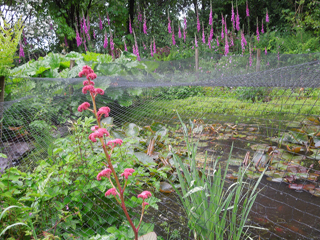
Keeping my camera in my bag and my umbrella open, I walked through the garden. It was an intimate garden. A large fishpond with lilies and a water-fall was covered with netting to protect dozens of goldfish from herons. A bog area at the far end of the pond was bordered with tall purple loosestrife (Lythrum salicaria). Joe Pye weed and yellow ox-eye daisy were also grown in the bog garden for the butterflies.
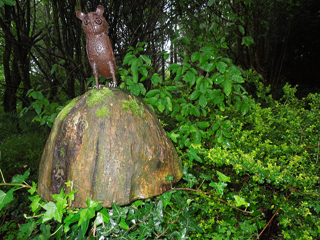
A winding path led to a woodland shade garden; a mix of trees (used as a shelter belt), shrubs and woodland plants. Garden art of carved wooden mushrooms sprouted from the earth with whimsical creatures perched on top. Pure white rugosa rose bushes along the edge of the woodland path contrasted against the deep green of the woods. Naturalized lavender digitalis and the red downward blooms of the Crinodendron hookerianum shrubs provided brief blotches of color. Under the canopy of the trees, it felt as though the rain had abated and photos of this delightful garden could be taken.
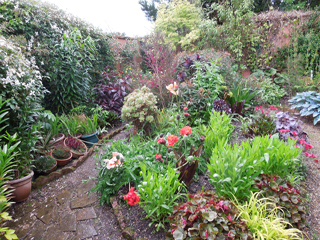
A wooden pergola covered in roses and clematis was the pathway to the ‘Secret’ Walled Garden where they have used color as a theme. Cool accents of blues and greens are on one side of the garden, hot colors on the opposite side. A waterfall surrounded with ferns, hostas, iris, the blue flowers of Cerinthe major, and agapanthus, are just a few of the soothing plants in the early June display. The large, frilly orange-red Oriental poppy, Turkenlouis showcased the hot colors of late spring.
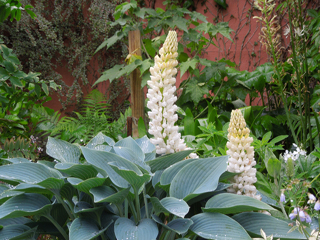
The outside south wall is used as a border that takes advantage of the shelter of the wall and the sun. Varieties of phlox, delphinium, liatris, poppy, flowering shrubs and a pure white lupine appropriately named ‘Noble Maiden’, are a few of the June blooming plants that thrive in this protected area. Wilson’s grow the lupines, prominent in several garden areas, by seed.
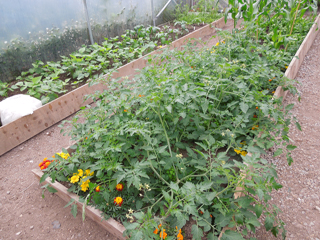
The pergola also serves as a screen for the polytunnel, which the Wilson’s find indispensable for growing early vegetables, over-wintering tender plants and raising seedlings and cuttings. On the day of our visit it was a respite from the rain and chill. A border of bright annuals was planted along the side of the polytunnel that was shrouded in mist. Besides their garden of ornamentals, space had been found on the acreage for a raised bed vegetable garden, raspberries, black currents and strawberries. They have apple trees but due to the high rainfall, they struggle with diseases. They have found Keswick Codling, an apple tree bred in the Lake District, (where the amount of annual rainfall is comparable) their most successful attempt at apple growing.
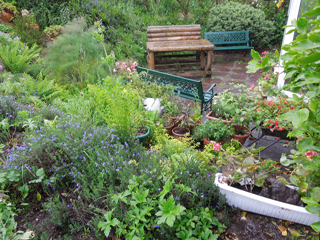
I was the last to leave the garden to enter Christine and Les Wilson’s home for English tea and biscuits. Blue rain barrels on the corners of the cottage were full, attesting to the average rainfall of 65 inches plus a year. A small rockery surrounded a brick patio with an herb garden for the kitchen and a conservatory for tender plants. It would have been the place to sit for refreshments and linger on a dry day. Instead, the group filled the downstairs living area as we listened to the story of the pair of English gardeners transplanted to southwest Ireland.
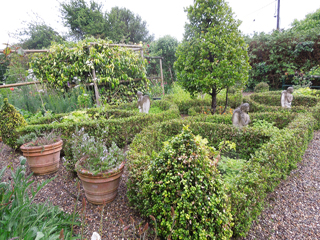
The Wilson’s bought the cottage which sat on an acre of grass field in 1990 as a holiday home. In 1996 they planted approximately 350 mixed trees and shrubs on the property. The next year they sold their residence in England and decided to move to Ireland and make the cottage at Aultaghreagh their permanent home. The garden was started in 1998 with the large pond and rockery, then the mixed borders. Over time they created the woodland and shade garden, removing many unnecessary trees. Where meadow grass had been, a one hundred foot double herbaceous mixed cottage style border was planted. They used many of the perennials they grew from seeds, division and cuttings. A parterre for scented herbs, (the only formality in the garden) a grass garden and the ‘Secret’ walled garden followed. A long escallonia hedge protects the garden from southwest gale force winds common in Ireland.
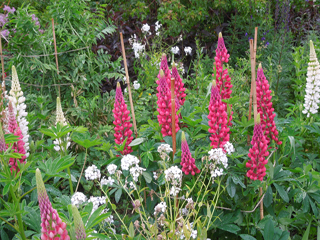
Christine and Les have brought an English garden with them to their permanent home in Ireland. They state that Christopher Lloyd influenced their style and planting. The Royal Horticulture Society Garden of Harlow Carr in Harrogate, North Yorkshire, though inspired the grass garden. The Wilson’s are not rare plant collectors but they do grow many unusual cultivars of perennials and shrubs and call their style quite “English.” I am under the impression that they take pride in the fact that it is just the two of them that designed, cleared, planted and now maintain this garden with over one thousand varieties of bulb, flowers, shrubs and trees. From their description of the continuous changes still taking place on their acreage, they epitomize the gardener “whose work is never done.”
The Wilson’s joint e-mail address of “houserocker@live,” indicates a second passion in the household. Les is a blues musician, singer and songwriter. As I left the cottage, Les commented that America gave them the blues and jazz. Across the waters we share not only our gardens but also, the universal language of music.
Visit this garden at: www.aultaghreaghcottagegarden.com